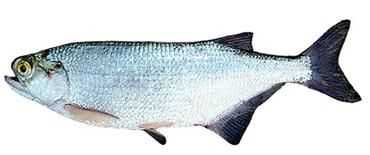Goldeye

Species Details
Hiodon Alosoides
Hiodontidae
Osteoglossiformes
Lakes, Rivers
1 - 3 lbs.
14" - 20"
What is the Goldeye Fish?
The goldeye fish is a herring-like fish that lives in cloudy rivers, marshy backwaters, and the shallow, muddy parts of larger lakes. It is called such because the color of its eyes turns golden when light reflects on them. It is an opportunistic carnivore that preys on smaller fish, crustaceans, and insect larvae.
Goldeye (Hiodon alosoides) Fish Description
Also known as shad mooneye, Winnipeg goldeye, yellow herring, weepicheesis, and toothed herring, the Goldeye belongs to the Hiodontidae family with the mooneye (Hiodon tergisus) as its only cousin. What distinguishes the two are the color of their eyes (the gold irises of the goldeye reflect light) and the position of their anal fins. The Goldeye’s dorsal fin starts opposite or behind the anal fin, whereas the mooneye’s begins before the anal fin.
Goldeyes resemble herrings (see the Pacific and Atlantic herring) but their most distinctive physical features are their large gold eyes and silver compressed bodies. From above, they appear blue-green silver and white silver from below. Their mouths are big and they have blunt round snouts. They have a fleshy keel found from their pectoral fins down to the end of their anal fin. They have two abdominal and pelvic fins and a dorsal fin on their back. Goldeyes have spineless cycloid scales.
Diet and Size
Goldeyes eat whatever they can get being an opportunistic carnivore. Their favorite menu items include fishes small enough to be swallowed, crustaceans, and insect larvae. They also added water fleas, frogs, mice, shrews, snails, and worms to their diet. These carnivorous species fall prey to larger fishes like the walleye, sauger, and northern pike.
On average, the Goldeye fish can grow only up to 17 inches and weigh 1 to 3 pounds. They can live up to 10 years but normally, Goldeyes reach up to 5-7 years of age. Male Goldeyes sexually mature when they reach 6-9 years old, whereas female Goldeyes do so at 7-10 years of age.
Interesting Facts About the Goldeye
- In Greek, Hiodon means “toothed hyoid” as in the ‘tongue bone’; alosoides means “shad-like'' in Greek and Latin, pertaining to how the Goldeye resembles a freshwater herring.
- The Goldeye is one of the 122 new species of fish and other animals documented by the Lewis and Clark Corps of Discovery.
- Goldeyes were recorded to have been commercially fished since 1876.
- They are popular to consumers as appealing smoked fish. A man from England who immigrated to Winnipeg made the (smoked) Goldeyes commercially viable in the 1890s; his name was Robert Firth.
- Smoked Goldeye is among the favorites of former President Woodrow Wilson and the Prince of Wales in the 1910s.
- The minor league baseball team Winnipeg Goldeyes named their team after this species of fish.
Fishing Techniques
Commercial anglers generally harvest Goldeyes in certain large lakes. Anglers can fish them using hook and line. Goldeyes are an important commercial species of fish in Canada. They also used to be very important in northern Minnesota.
Though not very popular with anglers, Goldeyes can be a good fly-fishing fish. Some anglers join the annual event where they gather at known Manitoba Goldeye hot spots to capture this fish. Anglers can fish them from July to September.
Habitat and Distribution
Goldeyes prefer cloudy rivers, marshy backwaters, and the shallow, muddy parts of larger lakes.
Goldeyes thrive in the Lake of the Woods and Red Lakes. They can be found in all of Minnesota’s drainage systems except in Lake Superior and the upper Mississippi River. They are located in the Mackenzie River, and from Alberta to Ohio (south of the Great Lakes), too. They used to inhabit Lake Winnipeg which was then the main commercial source of this species.







